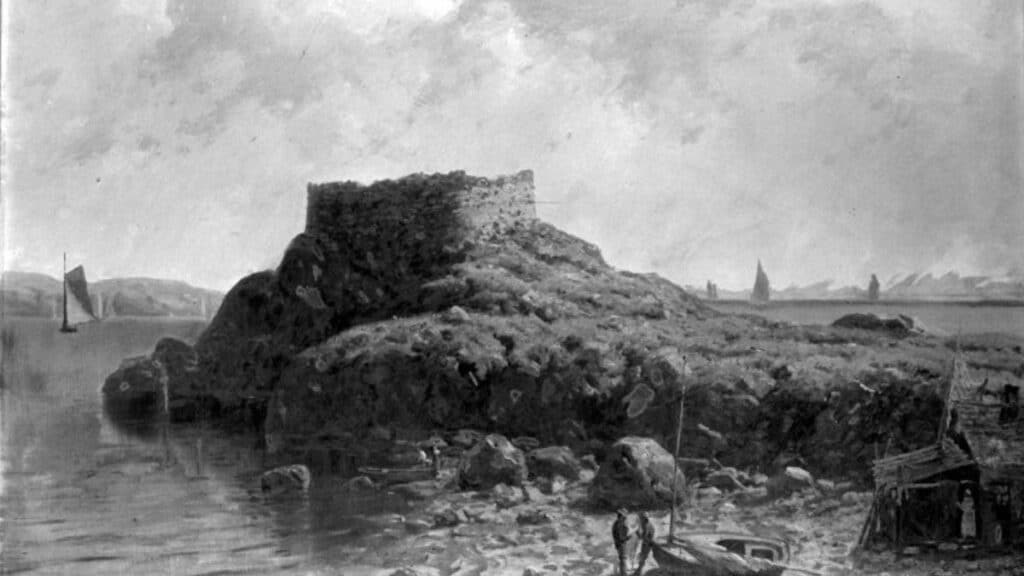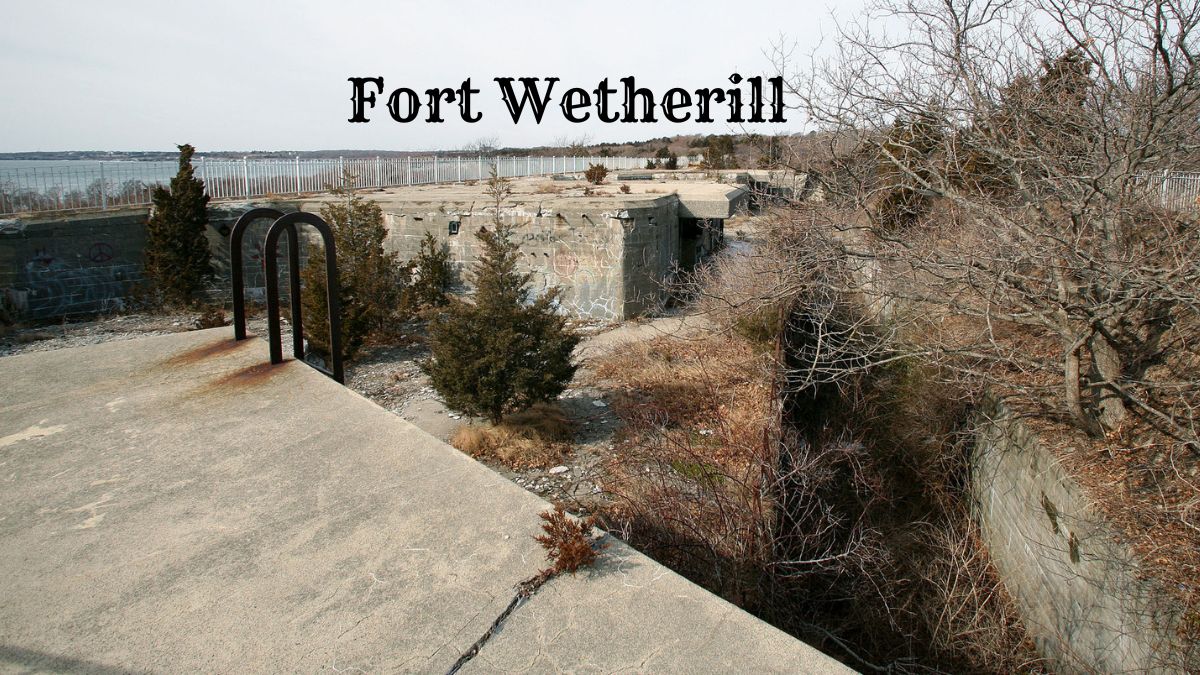Fort Wetherill in Jamestown, Rhode Island, is a captivating destination rich in history and natural beauty.
Located on Conanicut Island and overlooking Narragansett Bay, this decommissioned coastal defense fort offers visitors a unique blend of military heritage and scenic charm.
The fort’s network of tunnels and bunkers reflects its past significance, while its cliffs and coastal trails provide stunning ocean views.
The surrounding waters of Narragansett Bay are popular for scuba diving and boating, making Fort Wetherill a versatile spot for both history buffs and outdoor enthusiasts.
Whether you explore the remains of the fortifications or enjoy the picturesque landscapes, Fort Wetherill promises a memorable experience for all who visit.
History of Fort Wetherill

Colonial and military history converge at Fort Wetherill, showcasing significant events and figures that shaped the fort from the American Revolution to its current role as a state park.
Fort Dumpling, originally known as Fort Brown, was a historic coastal defense fortification situated on Conanicut Island in Jamestown, Rhode Island.
Overlooking the entrance to Narragansett Bay, it was constructed in the late 18th century and served as a strategic military post. The fort’s unique name derived from its rounded, dumpling-like shape.
Although it fell into disrepair and was eventually demolished in the early 20th century, its legacy endures through the site now occupied by Fort Wetherill State Park, offering visitors a glimpse into the region’s rich military history and stunning coastal views.
Transformations from the Revolutionary War to World War II
The site where Fort Wetherill stands today has undergone several transformations since its origins during the Revolutionary War.
After the war, it became part of a broader coastal defense network enhanced during the late 19th and early 20th centuries.
The fort was initially used as a submarine mining operation, crucial for protecting Narragansett Bay.
World War I marked another significant period for Fort Wetherill, transforming it into a training camp for new military recruits. Coastal defense batteries were modernized, and the fort’s significance grew during World War II.
The fort’s soldiers prepared for various conflicts, including the Battle of San Juan Hill, part of the larger Spanish-American War.
Named after Captain Alexander Macomb Wetherill, who fell in this battle, the fort remained a defensive stronghold throughout these critical periods.
Formation of Fort Wetherill State Park
After World War II, Fort Wetherill’s military importance waned. The U.S. military decommissioned the site, eventually transforming it into Fort Wetherill State Park.
This transition preserved the fort’s historic structures, which were added to the National Register of Historic Places.
Today, Fort Wetherill State Park is a popular destination for recreational activities. Visitors can explore the surviving fortifications, learn about the site’s significant military history, and enjoy panoramic views of Narragansett Bay.
The park’s establishment helps preserve the history of coastal defense and military training camps.
Geography and Natural Features

Fort Wetherill, located on the southeastern end of Conanicut Island, showcases prominent granite cliffs and breathtaking coastal landscapes.
This section provides an in-depth look at its geographic location and the natural features that define its surroundings.
Geographic Location and Accessibility
Fort Wetherill is situated at the East Passage of Narragansett Bay, part of the scenic region of New England. It is near the town of Jamestown, Rhode Island.
The fort’s location makes it accessible by road and offers ample parking for visitors.
The site is also water-accessible, with a small dock for boats. Visitors can see Dumpling Rock to the northwest and Fort Dumpling, which adds historical value to the area.
Public transportation options are limited, making private vehicles the most feasible way to visit.
Granite Cliffs and Coastal Landscapes
The granite cliffs at Fort Wetherill provide a dramatic backdrop against the water of the East Passage of Narragansett Bay. These cliffs offer stunning views and are a popular spot for hiking and photography.
The rugged terrain is compensated by well-marked trails, making exploration fairly easy.
The coastal landscape is rich in diverse vegetation, from short grasslands to dense bushes. The area around the cliffs includes several hidden coves and small beaches.
These natural features make Fort Wetherill a favored destination for picnicking, scuba diving, and enjoying the beauty of New England’s coastline.
Explore More: 10 Historic Forts in Rhode Island: A Journey Through Time
Recreational Activities
Fort Wetherill offers a variety of recreational activities that capitalize on its scenic landscapes and coastal waters.
Visitors can engage in scuba diving, boating, hiking, fishing, and picnicking and attend various events while enjoying breathtaking views.
Scuba Diving and Boating
Fort Wetherill is a popular destination for scuba diving enthusiasts. The park’s underwater terrain includes rocky outcrops, kelp forests, and an array of marine life.
Visibility is often good, making it an ideal spot for novice and experienced divers. Many local diving schools offer guided dives and equipment rentals.
Boating is another favored activity. Newport Harbor provides an excellent starting point for sailing and powerboating.
Boaters can enjoy the coastline views and participate in events such as the America’s Cup Races. Fort Wetherill’s boat ramp makes it easy to launch small vessels.
Hiking, Fishing, and Picnicking
Fort Wetherill’s hiking trails cater to all levels of hikers. Paths wind through wooded areas and along cliffs, offering panoramic views of the Atlantic Ocean.
Some trails lead to secluded spots perfect for fishing, where anglers can catch various saltwater fish.
Picnicking is popular, with numerous well-maintained picnic areas equipped with tables and grills.
Families and groups often gather here to enjoy meals and the picturesque surroundings. Open spaces provide plenty of room for games and relaxation.
Events and Sightseeing Opportunities
Fort Wetherill hosts numerous events throughout the year. Tall Ship events draw crowds, offering a chance to see historical vessels up close.
These events often include activities for children, food vendors, and live music, making them suitable for family outings.
Sightseeing opportunities are abundant. The fort’s historic structures and scenic views attract photographers and history buffs alike.
Viewing points along the coastline provide perfect spots to watch boats enter and leave Newport Harbor, especially during major sailing events like the America’s Cup Races.
Facilities and Amenities
At Fort Wetherill, visitors can enjoy various facilities and amenities that enhance their experience. These include scenic trails, picnic areas, family-friendly spaces, convenient parking, and accessibility options.
Trails and Walking Paths
Fort Wetherill boasts a network of well-maintained trails suitable for walking and hiking. The trails offer spectacular coastline views and are great for casual strolls and more vigorous hikes.
Pets are welcome but must be kept on a leash. Informational signs along the paths provide interesting facts about the area’s history and wildlife.
The paths are well-marked, ensuring that visitors can navigate them easily without getting lost.
Picnic Areas and Family Facilities
The park has ample picnic areas with tables and grills, perfect for family gatherings and outdoor meals.
Shaded spots provide relief from sunny days, and there are open spaces where children can play safely.
Restroom facilities are clean and conveniently located near the picnic areas. Some sections are specifically designated for family use, making it a great spot for group outings and family picnics.
Parking and Accessibility
Parking at Fort Wetherill is hassle-free, with several parking lots available near popular spots.
Spaces are marked, and there are dedicated spots for those with disabilities, ensuring accessibility for all visitors.
The park is designed to be accessible to everyone, with paved paths leading to key areas. Wheelchair users can enjoy many of the amenities without difficulty, making it an inclusive destination.
Conservation and Ecology
Fort Wetherill is a bastion of natural beauty and ecological diversity. These lands support thriving wildlife and verdant flora, making it a focal point for conservation efforts.
Wildlife and Birding
Fort Wetherill is a haven for many bird species. Birders frequent the area to observe Ospreys, Great Blue Herons, and various songbirds.
Migratory birds find refuge in its coastal and woodland areas.
Marine life, including harbor seals, can be spotted from the rugged cliffs. Conservation programs protect these habitats from disruption, ensuring wildlife thrives year-round.
Flora and Natural Preservation
The flora at Fort Wetherill ranges from coastal shrubs to hardwood forests. It is vital to preserve native plant species like Beach Plum and eastern red cedar.
Efforts focus on combating invasive species which threaten local biodiversity. Conservationists also monitor soil and water quality to maintain the health of these ecosystems.
Pathways are maintained to minimize human impact on sensitive zones, and interpretive signage educates visitors on the importance of flora conservation.
These efforts contribute to the overall health of Fort Wetherill, preserving its natural splendor.
Cultural Significance
Fort Wetherill has a rich cultural history that spans various influences and eras. Its presence in popular media and as a site for graffiti and public art highlights its unique role in contemporary culture.
Fort Wetherill in Popular Media
Fort Wetherill has appeared in several films and TV shows, which has brought national attention to its striking landscape.
Its rugged cliffs and abandoned structures provide an evocative backdrop perfect for dramatic scenes.
These appearances often focus on its historical and eerie qualities, featuring its ruins prominently.
Many local artists and filmmakers use the site for creative projects, capitalizing on its naturally picturesque views and rich history.
Fort Wetherill is recognized within Rhode Island and has gained a following far beyond the state, confirming its status as a culturally significant landmark.
Graffiti and Public Art

Graffiti at Fort Wetherill has transformed it into an open-air gallery. Artists around the region add vibrant colors and designs to the ruins, converting the site into a dynamic art space.
This transformation has sparked debate, mixing opinions about vandalism and community-driven art projects.
Some artworks honor the site’s military history, while others feature modern, abstract designs that contrast sharply with the rugged environment.
This intersection of old and new makes Fort Wetherill a living canvas that continues to evolve.
Public art initiatives have also brought more organized efforts to the area, with specific sections now dedicated to rotating exhibitions. These efforts celebrate artistic expression while acknowledging the site’s unique past.
Exploration and Safety
Fort Wetherill offers numerous exploration opportunities, focusing on its historical structures and ensuring visitor safety.
Key areas include the intricate tunnels, gun emplacements, and regulations to preserve these features.
Tunnels and Gun Emplacements
Fort Wetherill’s tunnels and concrete gun emplacements intrigue many visitors. These structures, once housing 12-inch guns, served as significant defense mechanisms.
There were rumors of German prisoners aiding in constructing some fortifications.
Safety is paramount when exploring these areas. Some tunnels are dark and can be disorienting.
It’s recommended to bring a flashlight and watch for uneven ground.
Fences surround various sections, guiding visitors and preventing accidents. Restrictions in certain zones help safeguard both individuals and delicate historical sites.
Regulations and Preservation Efforts
Regulations are in place to maintain Fort Wetherill’s condition.
Visitors must obey posted signs and stay within designated boundaries. Unscheduled modifications or removal of historical items are prohibited.
Preservation efforts include regular maintenance and specific visitor guidelines.
The site features informational displays about its history and significance. Tram tracks and other remnants are carefully maintained to prevent deterioration.
Authorities work continuously to balance public access with conservation.
They ensure Fort Wetherill remains a safe and enriching site for all.

Cory is a website owner and content creator who enjoys fishing, history, coin collecting, and sports, among other hobbies. He is a husband and father of four.
Romans 15:4 For whatever was written in former days was written for our instruction, that through endurance and through the encouragement of the Scriptures we might have hope.

